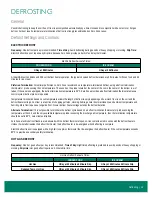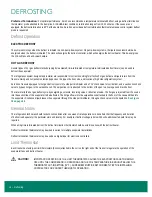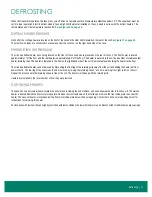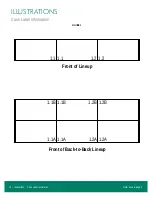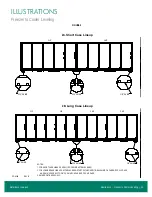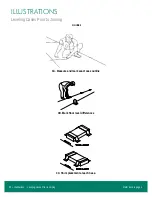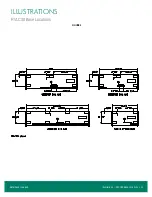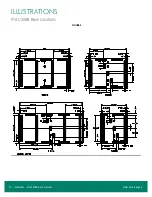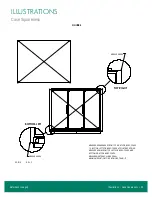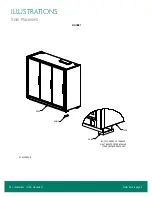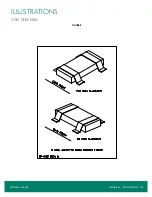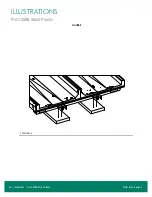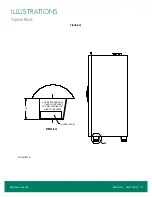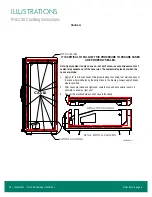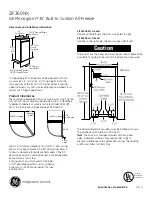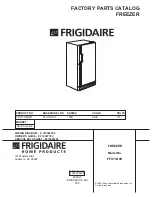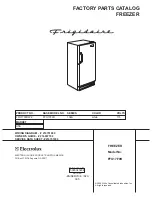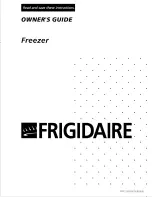
Electrical • 13
ELECTRICAL
General
!
CAUTION!
DISCONNECT POWER TO THE CASE BEFORE SERVICING ELECTRICAL COMPONENTS TO AVOID PERSONAL
INJURY AND DAMAGE TO THE UNIT.
for the typical wiring diagram for a low temperature case equipped with electric defrost.
for the typical wiring diagram for a low temperature case equipped with hot gas defrost. Each case is provided with a wiring diagram located in
the electric box that shows the exact wiring of the case.
There are many control options available for multiple case defrost systems. Wiring diagrams and instructions can be obtained by contacting
Zero Zone’s Service Department.
External wiring should be sized according to the amperage rating stamped on the serial plate. The serial plate is located on the ceiling inside
the left-hand door. Typical electrical values are shown on specification sheets for each of these cases in the bag attached to the case or are
available at www.zero-zone.com. All internal wiring has been done at the factory. Cases with standard wiring have their control wires terminated
in an electrical box located on top of the case. A terminal block has been used to simplify field connections.
All wiring must comply with the National Electrical Code and all local codes. After installation of the equipment, correct operation of the electrical
circuits and controls and defrost operation and termination should be verified. All operating voltages and amperages should be measured and
recorded.
Optional Electrical Wiring
SINGLE POINT CONNECTION
The “single point” connection system is designed to reduce the time required to install and wire one display case with one condensing unit.
are typical diagrams for this system.
All of the display case controls, including the disconnect switch and the electronic case controls are installed on the case and pre-wired. The
liquid line solenoid valve is installed in the liquid line and wired. The power to operate the display case is connected at the case disconnect
switch. The power to operate the condensing unit is connected in the condensing unit control panel. There are no interconnecting wires between
the condensing unit and display case.
The controls operate the system as a pump down defrost. When the display case begins defrost, the liquid line solenoid valve, fans and
anti-sweat heaters are de-energized. The defrost heaters are energized. The compressor continues to run and pumps down the coil. The
compressor cycles off on its low-pressure control. If there is any residual liquid left in the coil, the suction line pressure will rise and the
compressor may turn on and pump down the coil.
The liquid line solenoid is energized at the end of the defrost cycle and the defrost heaters are de-energized. The suction line pressure rises
and the compressor starts. When the low temperature evaporator reaches operating temperature, the fans and anti-condensate door heaters
are energized.
MASTER/SATELLITE CONNECTION
The master/satellite connection system allows one condensing unit to be connected to multiple cases.
typical diagram for this system.
All of the display case controls, including the disconnect switch, time clock, temperature control, and defrost temperature control, are installed
on the case and pre-wired. The liquid line solenoid is pre-wired but is not installed in the liquid line.
The power to operate each display case is connected at each case’s disconnect switch. The power to operate condensing unit is connected
at the condensing unit. There are no interconnecting wires between the condensing unit and display case. There are interconnecting wires
Summary of Contents for CRYSTAL MERCHANDISER
Page 25: ...Illustrations Case Squareness 23 Illustrations Figure 6 Case Squareness Refer back to page 5...
Page 26: ...24 Illustrations Shim Placement Illustrations Figure 7 Shim Placement Refer back to page 5...
Page 27: ...Illustrations Shim Orientation 25 Illustrations Figure 8 Shim Orientation Refer back to page 5...
Page 29: ...Illustrations Spacer Block 27 Illustrations Figure 10 Spacer Block Refer back to page 6...
Page 34: ...32 Illustrations Drain Line Illustrations Figure 15 Drain Line Refer back to page 7...
Page 38: ...36 Illustrations Electrical Box Illustrations Figure 19 Electrical Box Refer back to page 11...

















